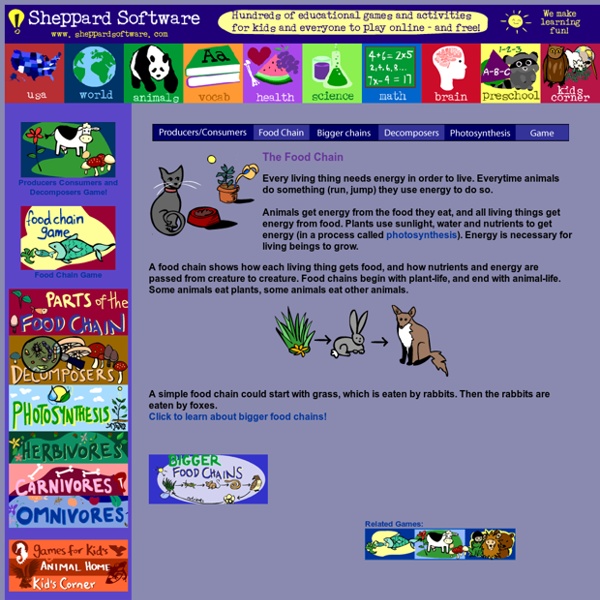Animals
www.kidcyberteachers.com.au Need help planning classroom activities? Go here to the kidcyber resources for teachers website and find a collection of practical, low cost teaching materials in a variety of curriculum areas to help you 'put it all together'. Our units cost just a few dollars, making it possible for you to buy your own copy. We would like to continue to write for you but we need the few dollars for each copy to make a living and keep our site online.
Animals
As of July 1, 2013 ThinkQuest has been discontinued. We would like to thank everyone for being a part of the ThinkQuest global community: Students - For your limitless creativity and innovation, which inspires us all.
Animal Lapbooks FREE
Materials and information on this website belong to the original composers. It may be used for your own personal and school use. Material may not be used for resale. © 2005-07 HSS
Teach the Children Well-Animals
AdaptationAdaptations to A Desert BiomeAnimal AdaptationsAnimal Adaptations and SurvivalAnimal Adaptations GameAnimal Adaptations E-SafarisAnimal CamouflageAnimal DiversityAnimals and AdaptationAnimals, Adaptation and the Galápagos IslandsThe Body ChangersBuild a BeastCamouflageDirtmeister's Animal AdaptationsEvolutionHot or ColdHow Animals Meet Their NeedsHow Plants and Animals Survive the WinterMimicryPenguin AdaptationUnderstand Wildlife Winter Survival StrategiesWacky Animal DefencesWhat Do Animals Do in Winter?What Does Adaptation Mean?Wildlife in Winter--Adaptations for SurvivalWinter Adaptations of Animals Amazing Bats of Bracken CaveBat Conservation InternationalBats!Bats Are CoolBats at Enchanted LearningBats in AustraliaBatty About BatsBat WorldBouncing SoundsChiropteraEcholocation VideoEcho the BatHow to Build a Bat HouseIs That A Lark I Hear?
food chain
The food chain describes who eats whom in the wild. Every living thing—from one-celled algae to giant blue whales—needs food to survive. Each food chain is a possible pathway that energy and nutrients can follow through the ecosystem. For example, grass produces its own food from sunlight.
Ocean Food Web
Peer into an underwater world. What’s on the menu in the ocean café? In this cool science fair project, discover how tiny ocean life feeds some of the largest animals on the planet.
Camoflauge in Animals
Mimicry Some animals and plants look like other things -- they mimic them. Mimicry is another type of deceptive coloration. It can protect the mimic from predators or hide the mimic from prey. If mimicry was a play, there would be three characters.
Zoology
Photos: (A special thanks to the California Academy of Sciences for their generous photo contribution); Introductory page American robin, Asian multicolored ladybird beetle, crocodile skink, Jeffery pine, long-tailed salamander, red lionfish, robust lancetooth, smooth flower coral, Salmonella enteriditis: refer to Organism Pages credits below; Joel Cracraft: courtesy of Joel Cracraft, AMNH Cladogram page DNA: courtesy of Denis Finnin, AMNH, The Genomic Revolution Exhibit animals: AMNH, spectrum of life in Hall of Biodiversity; Bilateria: formosan subterranean termite: courtesy of Scott Bauer, Agricultural Research Service; vertebrates, tetrapods, sauropsids, diapsids: AMNH, Hall of Vertebrate Origins; How to Read a Cladogram page: fruit photos excluding watermelon: AMNH; watermelon: courtesy of Ken Hammond, U.S. Department of Agriculture; Organism pages: True Bacteria: Escherichia coli: courtesy of Michael Elowitz Nodularia: Hans Paerl, author.
Inspiring images
View our archive of stunning photography, courtesy of 2020VISION, the biggest photography-based conservation project ever undertaken in the UK. www.2020v.org Redstarts are immediately identifiable by their bright orange-red tails, which they often quiver. Redstarts ‘bob’ in a very robin-like manner, but spend little time at ground level. Puffins’ short wings are adapted for swimming with a flying technique under water. In the air, they beat their wings rapidly (up to 400 times per minute) in swift flight, often flying low over the ocean’s surface.



